Childhood obesity
Last Modified 25/10/2023 14:14:46
Share this page
Introduction
The World Health Organization (WHO) regards childhood obesity as one of the most serious global public health challenges for the 21st century and ending childhood obesity is one of the most complex health challenges facing the international community during this century1.
Over a fifth (22%) of children are overweight or obese when they begin school, and this figure increases to over a third (37%) by the time they leave primary school. Furthermore, the most deprived children are twice as likely to be obese both at Reception and at Year 6 as the least deprived children.
Once established, obesity is notoriously difficult to treat, so prevention and early intervention are very important. Obese children and young people are more likely to become obese adults2 and have a higher risk of morbidity, disability and premature mortality in adulthood.
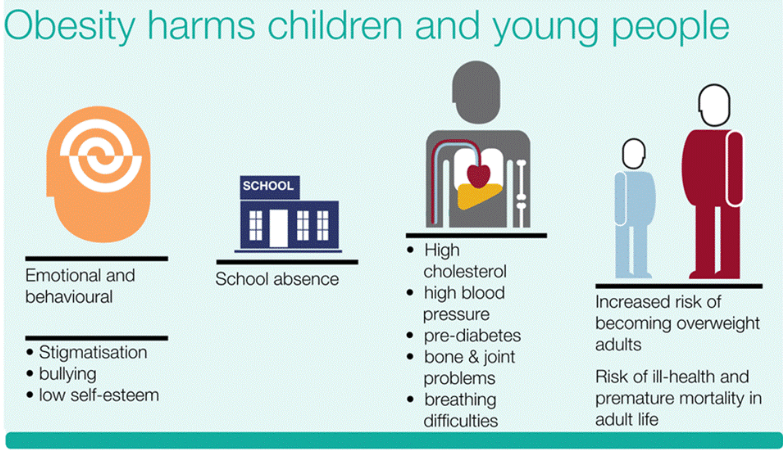 Source: OHID, Childhood obesity: applying All Our Health, April 2022
Source: OHID, Childhood obesity: applying All Our Health, April 2022
Obesity is a consequence of poor diet and a lack of physical activity. Unlike most adults, many children and young people cannot choose the environment in which they live or the food they eat. They also may not understand the long-term consequences of their behaviour. They therefore warrant special attention in national and local strategies and plans to tackle the obesity epidemic.
The National Child Measurement Programme (NCMP) is an important element of the Government’s work programme on child obesity. Blackpool Council has a legal responsibility to undertake the NCMP and every year children in Reception (aged 4-5 years) and Year 6 (aged 10-11 years) have their height and weight measured to inform local planning and delivery of services for children, and gather population-level surveillance data to allow analysis of trends in growth patterns and obesity.
The impact of obesity is also discussed in the sections on adult obesity, healthy eating, diabetes and physical activity.
Facts, figures and trends
Please note: The National Child Measurement Programme (NCMP) was affected by the impact of Covid-19 over the 2019/20 and 2020/21 academic years. Due to school closures and disrupted learning, the NCMP did not commence at the start of the 2020/21 school year and a decision was made to collect a nationally representative sample of 10%. Some local authorities (including Blackpool) did collect a full dataset and their results are available.
In 2022/23, NCMP data for England reported that 12.2% of reception children were overweight, and a further 9.2% were obese. Of these 2.5% were severely obese. For children in Year 6, 13.9% were overweight and a further 22.7% obese, of which 5.7% were severely obese.
Following significant increases in excess weight during 2020/21 (the first year of the pandemic) rates of overweight and obesity have fallen back in line with overall trends both nationally and locally.
The NCMP data collected from Blackpool primary schools in 2022/23, reported by NHS Digital, shows:
-
-
- 3,020 valid measurements were received for children with postcodes in the Blackpool area.
Reception:
- 175 (12.0%) Reception children were classed as obese in 2022/23; this was a slight fall from the previous year, 12.3% in 2021/22, and is back in line with the trends seen pre-pandemic.
- This prevalence rate is still significantly higher than the national average of 9.2%.
- 400 (27.4%) of the children measured were either overweight or obese (excess weight). This is a slight increase from the previous year, 26.5% in 2021/22 but similar to the 2019/20 rate of 28.5%.
- The prevalence of excess weight is significantly higher than the national average of 21.3%.
Year 6:
- 420 children were obese, a prevalence rate of 26.9%, a fall from last year’s rate of 29.5%
- It is significantly higher than the national average of 22.7%
- 660 (42.3%) of the children measured were either overweight or obese. Again, this is a fall from the previous year's figure of 43.0% but still an increase on the 2019/20 rate of 40.9%
- Excess weight prevalence is significantly higher than the national average of 36.6%
Figure 1 and figure 2 show how the proportion of children who are obese in Blackpool more than doubles between Reception age and Year 6 from 12.0% to 26.9%.
-
-
- The proportion who are overweight in Blackpool is the same in Reception and Year 6, likely to be accounted for by the large shift towards obesity.
- Severe obesity in Blackpool is higher than the national average at Reception and significantly higher at Year 6, more than doubling from 3.1% at Reception to 8.0% at Year 6.
Figure 1: Weight classification of Reception (age 4-5 years) children in Blackpool and England: 2022/23 (%)
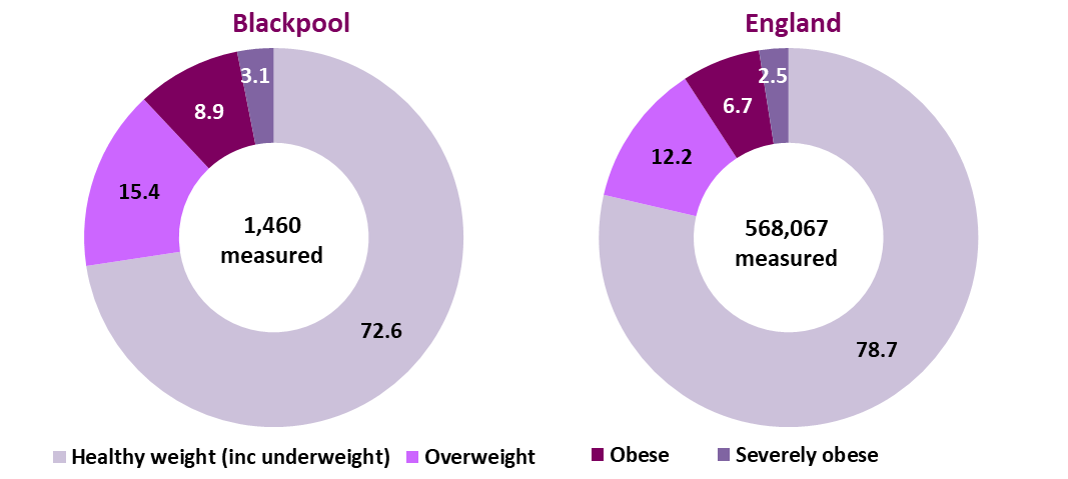 Source: NHS Digital: National Child Measurement Programme, 2022/23 (area of residence of child)
Source: NHS Digital: National Child Measurement Programme, 2022/23 (area of residence of child)
Figure 2: Weight classification of Year 6 age (10-11 years) children in Blackpool and England: 2022/23 (%)
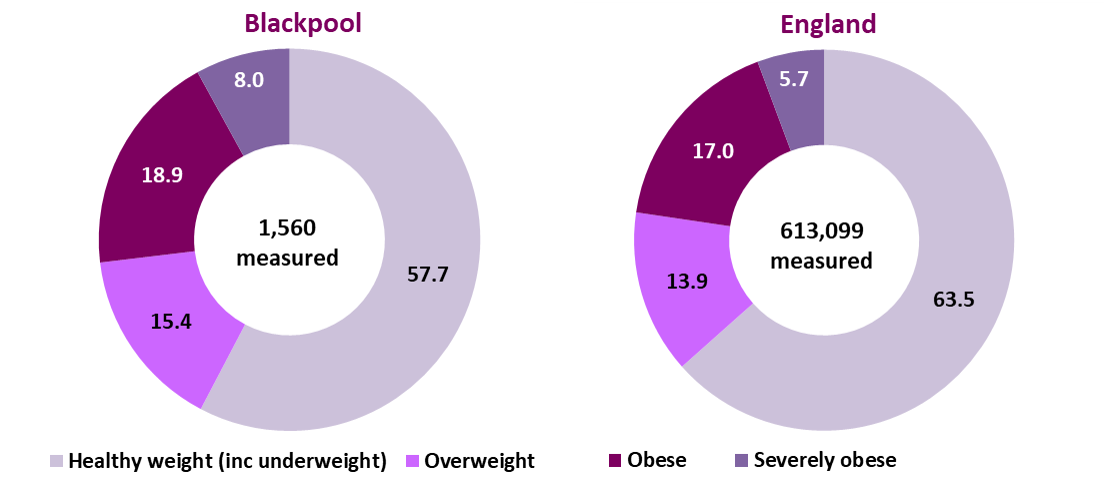 Source: NHS Digital: National Child Measurement Programme, 2022/23 (area of residence of child)
Source: NHS Digital: National Child Measurement Programme, 2022/23 (area of residence of child)
Figure 3: Prevalence of underweight, healthy weight, overweight, obese and severely obese children, 2022/23, England, North West and Blackpool
| | Underweight | Healthy weight | Overweight | Obese (inc. severely obse) | Severely obese | Excess weight (overweight and obese) | Number measured |
|---|
| Reception |
|---|
| England |
% |
1.2 |
77.5 |
12.2 |
9.2 |
2.5 |
21.3 |
568,067 |
| North West |
% |
1.0 |
75.8 |
13.1 |
10.1 |
2.6 |
23.1 |
76,680 |
| |
Blackpool |
% |
1.0 |
71.6 |
15.4 |
12.0 |
3.1 |
27.4 |
1,460 |
| No. |
15 |
1,045 |
225 |
175 |
45 |
400 |
| Year 6 |
|---|
| England |
% |
1.6 |
61.9 |
13.9 |
22.7 |
5.7 |
36.6 |
613,099 |
| North West |
% |
1.4 |
60.3 |
14.5 |
23.8 |
6.1 |
38.3 |
84,430 |
| |
Blackpool |
% |
1.0 |
56.7 |
15.4 |
26.9 |
8.0 |
42.3 |
1,560 |
| No. |
15 |
885 |
240 |
420 |
125 |
660 |
| Source: NHS Digital, National Child Measurement Programme 2022/23 (area of residence of child). Numbers are rounded to the nearest 5. |
Further analysis by NHS Digital has found that, nationally and regionally, the prevalence of obesity was higher among boys than girls in both age groups and a higher percentage of girls were of healthy weight than boys. As in previous years there was a strong relationship between deprivation and obesity in both age groups; the gap between obesity prevalence for the most and least deprived areas remains similar over time in both school years3.
Changes in children's body mass index between 2006/07 and 2022/23
Year-to-year variation around the prevalence figures do exist and changes from one year to the next are not always indicative of the long term trend.
Figure 4 shows the trend over time in the prevalence of excess weight (overweight and obese combined) by year of measurement and school age (Reception and Year 6). There is clearly an upward trend in excess weight in school children in Blackpool and this is more evident in the older Year 6 age group, where the proportion of pupils who were overweight or obese increased from 27.9% in 2006/07 to 42.3% in 2021/22, though there has been decreases over the last two years. Although the pattern is similar to the national trend, the rate of increase is steeper in Blackpool. The sharp increases seen locally and nationally in 2020/21 do seem have fallen back in line with previous trends.
For Reception age children, proportions overweight or obese have risen more slowly, ranging from from 22.3% in 2007/08 to the high of 36.7% we saw in 2020/21. Rates in 2021/22 have fallen back to where they were pre-pandemic. The trend and rates in both age groups were generally in line with national averages until 2011/12 when the trend began to rise and the gap between Blackpool and England began to increase. Whilst dipping back towards national average in 2016/17, the Year 6 rate has until now increased every year since then.
Each coloured point highlighted on the trend lines (Figure 4) represents the same cohort of children in Blackpool who have moved through the school years since the NCMP began. Therefore the children measured in Reception in 2006/07 were the same cohort of children who were measured in Year 6 in 2012/13. There is generally a large increase in excess weight between Reception children and Year 6 children, and this is also the case in Blackpool where the proportion overweight and obese has increased by 17% as the children have got older.
Figure 4: Trend in excess weight prevalence for Reception and Year 6 showing a cohort comparison, 2006/07 to 2022/23: Blackpool compared to England (percentage with excess weight)
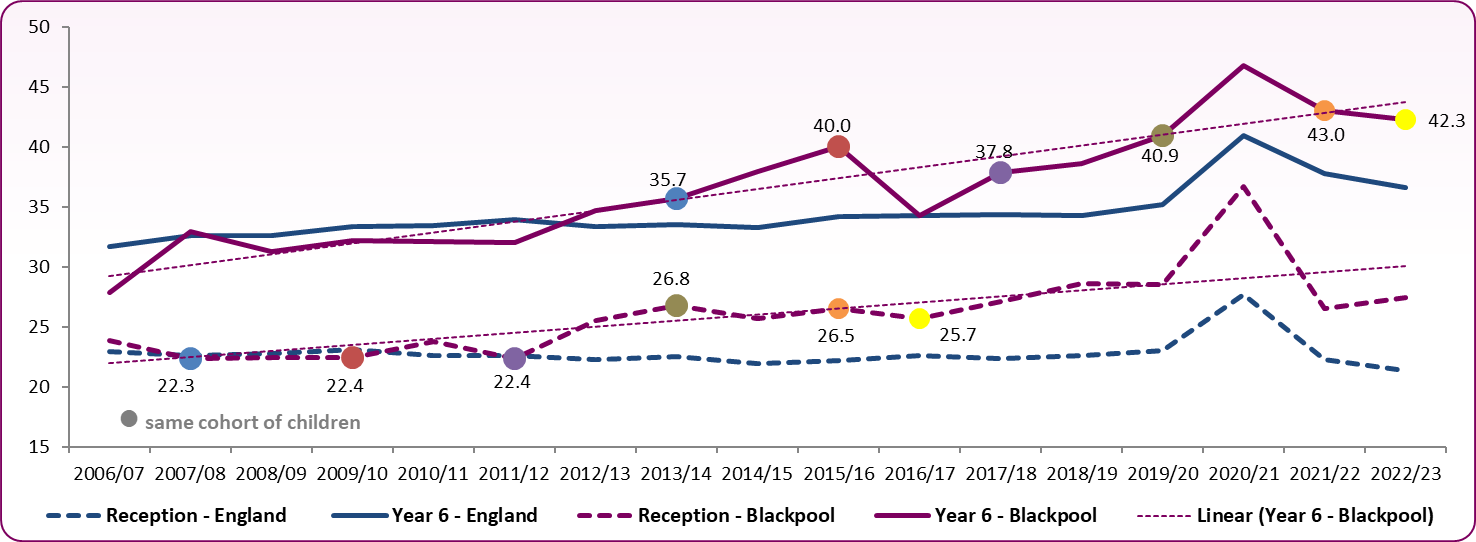 Source: NHS Digital: National Child Measurement Programme
Source: NHS Digital: National Child Measurement Programme
Figure 5 shows the overall trend over time in the prevalence of obese children by year of measurement and school year (Reception and Year 6). There is clearly an upward trend in levels of obesity in Year 6 children in Blackpool where the proportion of pupils who are obese has increased from 15.9% in 2006/07 to 26.9% in 2022/23 although there has been a fall over the last two years. This trend in obesity at a national level had almost levelled out by 2019/20 before increaseing during the pandemic. The fall in obesity in Blackpool in 2022/23 shows rates are now back to pre-pandemic levels for Reception and Year 6 children and for Year 6, the gap between Blackpool and England has narrowed slightly. For Reception age children, the gap between Blackpool and England has increased slightly in 2022/23. The national trend in obesity at Reception age had remained relatively stable over the period of the programme and the sharp rise seen locally and nationally in 2020/21 has now fallen back in line with previous trends.
It can be seen from the cohort comparison (figure 5) that in Blackpool, obesity is increasing between Reception children and Year 6 children with the proportion classed as obese more than doubling over the time period, though that gap did decrease slightly in 2022/23 as fewer Year 6 children are classified as obese.
National and local increases in the numbers of overweight and obese children in England reported during the Covid-19 period 2020/21 were a concern, showing the impact of the Covid-19 lockdowns and restrictions on children that may have exacerbated existing high levels of excess weight. Those increases now appear to be back to following pre-pandemic trends.
Figure 5: Trend in obesity prevalence for Reception and Year 6 showing a cohort comparison, 2006/07 to 2022/23: Blackpool compared to England (percentage obese)
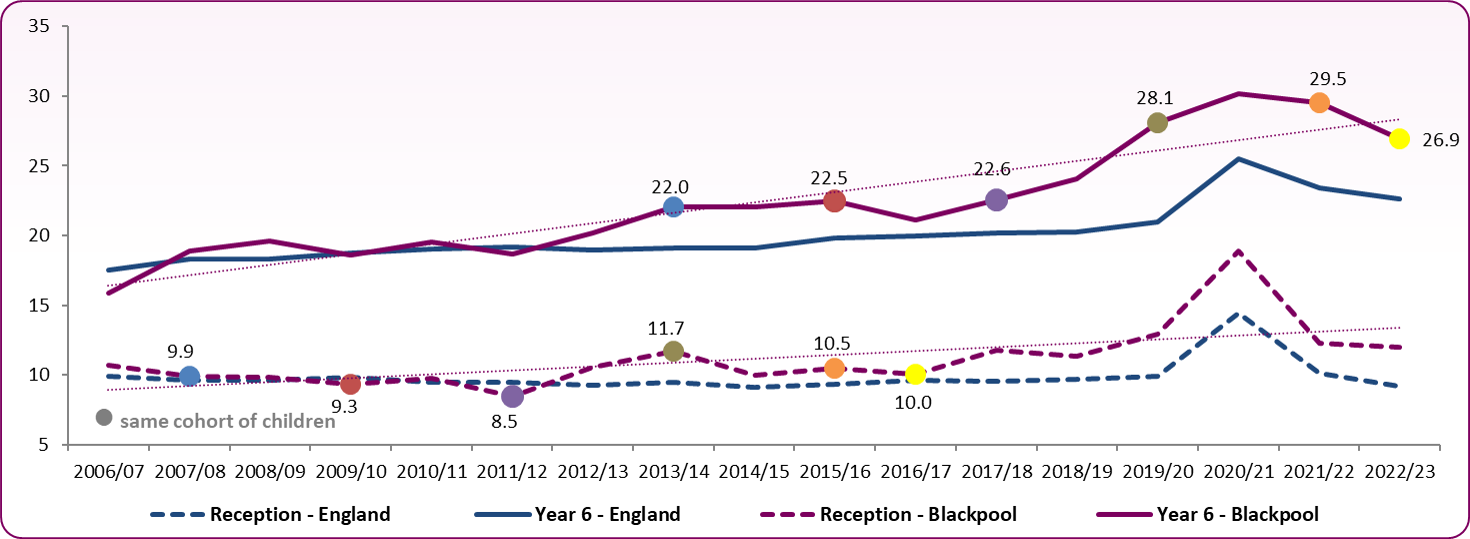 Source: NHS Digital: National Child Measurement Programme
Source: NHS Digital: National Child Measurement Programme
Local variations in children's excess weight
At a local level, there is wide variation in excess weight across Blackpool. Combined data from the NCMP, 2019/20 to 2021/22 (Figure 6), shows that excess weight at age 4-5 years ranges from 23.1% in Stanley to 32.7% in Park and obesity ranges from 9.1% in Talbot to 16.4% in Park. Park also has the highest proportion (47.5%) of children with excess weight at Year 6 while Bispham has the lowest proportion (31.3%). It can be seen quite clearly that while the proportion of overweight children generally stays the same over time, the rates of obese children double between Reception age and Year 6. Figure 7 shows the local variation in excess weight geographically for the 2019/20-2021/22 period. Care should be taken when interpreting data at ward level as the numbers of children who are overweight or obese in each ward are relatively small and rates do fluctuate over time.
Figure 6: Proportion overweight and obese (excess weight) by ward in Blackpool: 2019/20-2021/22 (3 years combined data)
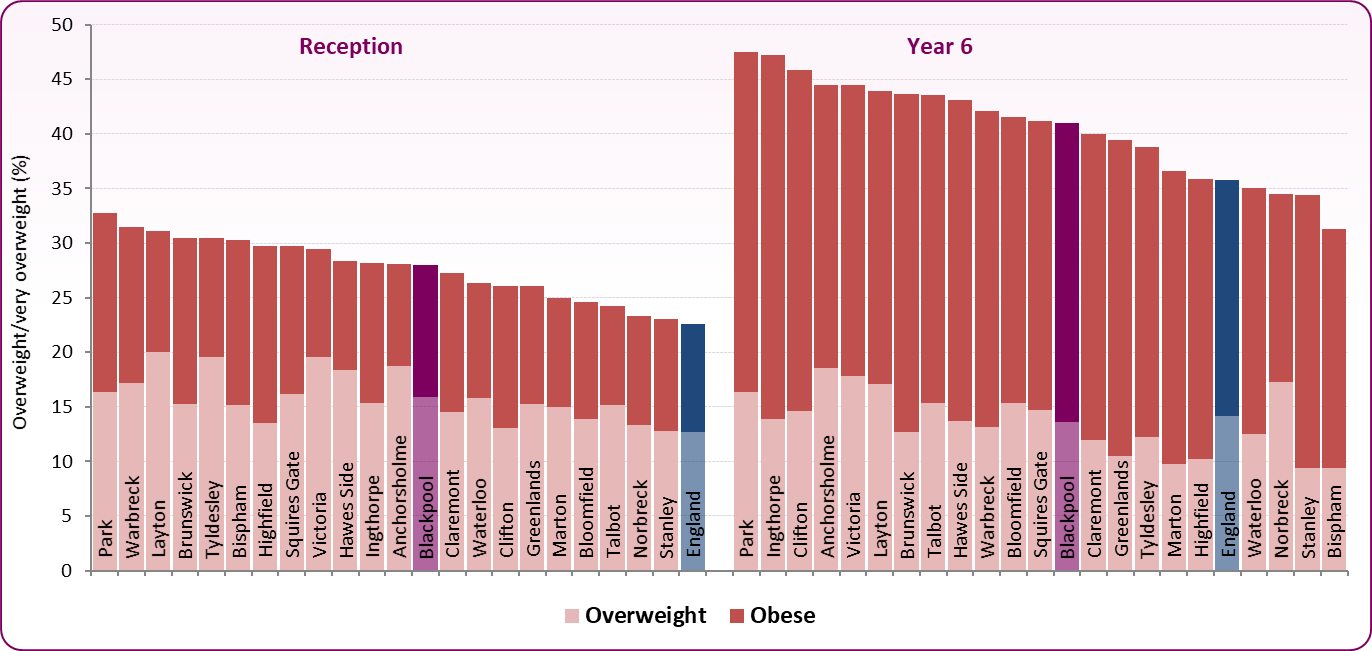 Source: OHID, Local Health - Small Area Public Health Data
Source: OHID, Local Health - Small Area Public Health Data
Figure 7:Proportion with Excess weight in Reception and Year 6 children in Blackpool by ward, 2019/20-2021/22
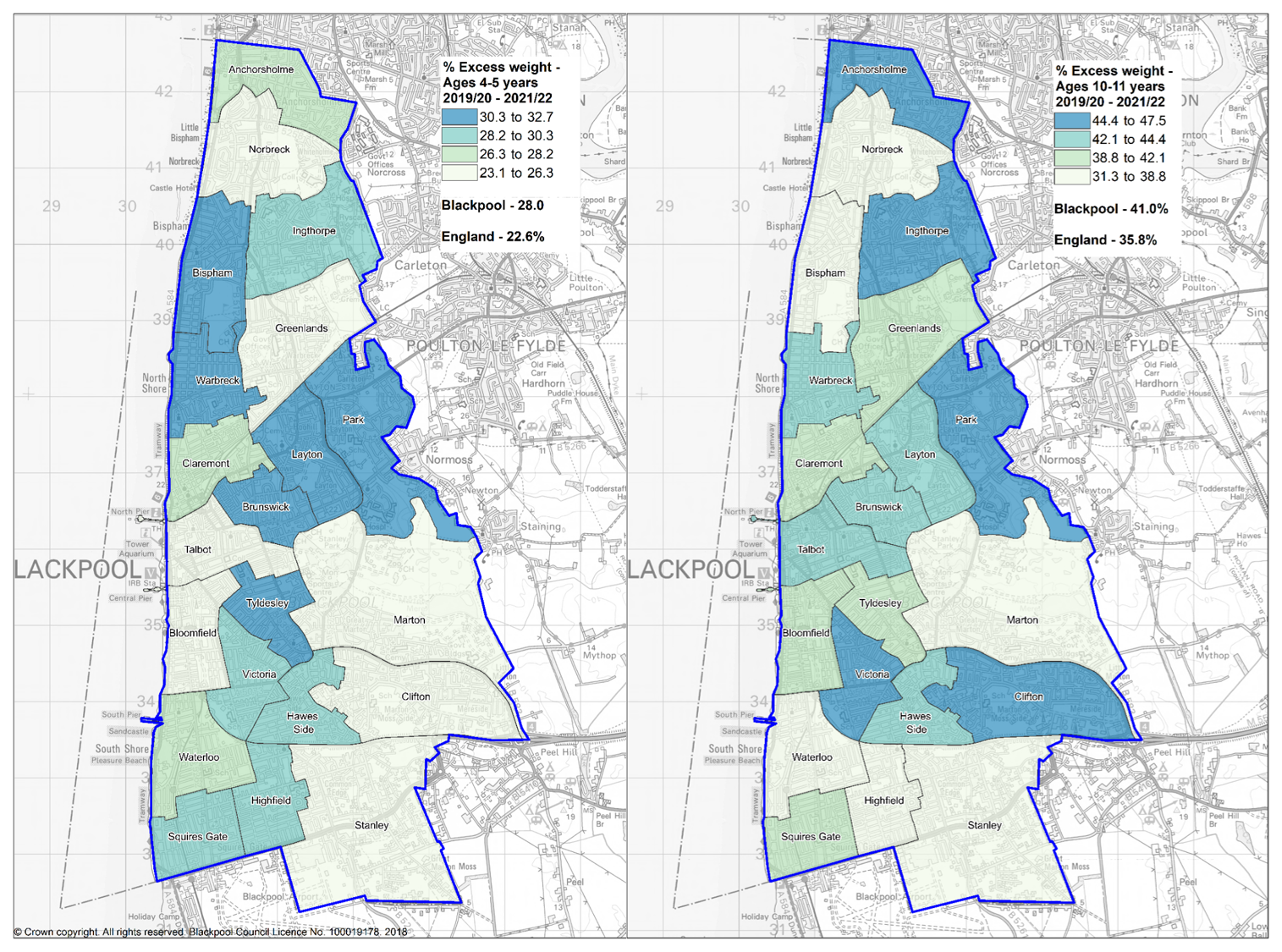 Source: OHID, Local Health - Small Area Public Health Data
Source: OHID, Local Health - Small Area Public Health Data
Perception of own body-image
Data from the Health Related Behaviour Survey 2022 showed 27% of boys and 47% of girls in Year 6 in Blackpool primary schools reported that they worried ‘quite a lot’ or ‘a lot’ about the way they looked.
43% wanted to lose weight (increasing to 53% by age 15). Only a third of pupils are happy with their weight by the time they are in secondary school.
The What About YOUth? 2014 survey collected information on a range of health behaviours amongst 15 year olds and one of the topics covered was their perception of their own body-image.
Nationally, half (52%) of all young people thought their body was 'about the right size'. 12% thought they were 'a bit too thin', and 2% thought they were 'much too thin'. Just over a quarter (28%) thought their body was 'a bit too fat' and 6% thought they were 'much too fat'. Perception of body-image varied greatly by gender, with boys being more likely than girls to think they were 'too thin', and girls being more likely than boys to think they were 'too fat'. 18% of boys thought they were 'too thin', compared with 8% of girls. In contrast, 46% of girls thought they were 'too fat', compared with 23% of boys.
Some studies have found that weight and BMI are correlated with body dissatisfaction, with young people who are overweight or obese reporting greater depressive symptoms and lower self esteem than their peers.4
Disability and obesity: the prevalence of obesity in disabled children
PHE examines the evidence linking disability and obesity among children and young people. The paper looks at a range of impairments or health conditions associated with disability and explores the main obesity-related chronic health conditions that can develop during childhood and adolescence. It also draws attention to the inequalities experienced by children and young people in relation to obesity and disability and highlights implications for policy, practice and research.
PHE, Obesity and disability, children and young people  (390 KB)
(390 KB)
While we do not have any Blackpool specific data on obesity in children who have a disability we do know that 13% of young people have been diagnosed with a long-standing illness or disability in Blackpool5 and over 700 school children have been identified as having a learning disability6.
The report from PHE suggests the risk of obesity among children and young people with disabilities may be related to personal factors such as genetic or metabolic complications, diet, levels of physical activity or use of medications with a side-effect of weight gain.
Environmental factors such as inaccessible neighbourhoods and lack of access to recreational facilities and programs may also play an important role in this relationship. It has been suggested that unusual dietary patterns and fewer opportunities to engage in physical activity may be linked to higher prevalence of obesity in children with developmental disorders, and some conditions, such as Prader Willi syndrome, may give children a predisposition to overeat. Children with autism may be averse to certain textures, flavours or colours, leading them to eat a very limited range of foods, while lack of social participation can also trigger feelings of isolation and result in a risk of overeating in children with disabilities.
National and local guidance
Childhood obesity: a plan for action (updated January 2017) is the government’s plan for action to significantly reduce childhood obesity by supporting healthier choices.
Childhood obesity: a plan for action, chapter 2 (June 2018) outlines the actions the government will take towards its goal of halving childhood obesity and reducing the gap in obesity between children from the most and least deprived areas by 2030.
NICE Guideline CG189 Obesity: identification, assessment and management (July 2023) offers evidence-based advice on the care and treatment of obesity and new recommendations have been added about low-calorie and very low-calorie diets, bariatric surgery and follow-up care.
NICE Quality Standard QS94 - Obesity in children and young people: prevention and lifestyle weight management programmes (July 2015) covers a range of approaches at a population level to prevent children and young people aged under 18 years from becoming overweight or obese
NICE Guideline PH47 - Weight management: lifestyle services for overweight or obese children and young people (October 2013) makes recommendations on lifestyle weight management (sometimes called tier 2) services for overweight and obese children and young people aged under 18.
NICE guideline [NG7] Preventing excess weight gain (March 2015) covers behaviours such as diet and physical activity to help children (after weaning), young people and adults maintain a healthy weight or help prevent excess weight gain.
NICE guideline [CG43] Obesity prevention (updated March 2015) covers preventing children, young people and adults becoming overweight or obese. It outlines how the NHS, local authorities, early years’ settings, schools and workplaces can increase physical activity levels and make dietary improvements among their target populations.
Public Health England’s blog posts provide expert insight on the organisation's work relating to obesity: Childhood obesity: 4 important developments and Changing the obesity landscape – 5 ways we’re taking on one of the nation’s biggest health problems
Services
Active Blackpool's Making changes (blackpool.gov.uk) is a free lifestyle service for families with children aged between 4 and 11 who want help and advice with maintaining a healthy weight. They can help families with:
- Healthy eating advice, including portion sizes, food labelling and hydration
- Family exercise sessions with a dedicated instructor
- A support plan including eating on a budget and cooking at home
- Sessions in the gym and classes, low rope session, climbing wall session and a bouldering wall session.
- 3 months FREE access to Blackpool Council’s sports and leisure facilities on completion of the programme
[] World Health Organization. Report of the commission on ending childhood obesity 2016
[] Simmonds M, et al. The use of measures of obesity in childhood for predicting obesity and the development of obesity-related diseases in adulthood: a systematic review and meta-analysis. Health Technol Assess 2015;19(43)
[] NHS Digital, National Child Measurement Programme, England, 2022/23, October 2023
] Mental Health Foundation, Body image in childhood [Accessed 25/10/2023]
] PHE, Child Health Profile, Long term conditions and complex health needs
PHE, Learning Disability Profile